Tracing the History and Evolution of Public Administration Practices
VerifiedAdded on 2023/06/04
|11
|2482
|423
Essay
AI Summary
This essay provides a detailed overview of the history of public administration, tracing its evolution from ancient times to the modern era. It explores the role of key figures like President Thomas Jefferson and the impact of events like the industrial revolution. The essay also examines American bureaucracy through the lens of Weber, Merton, and Herring, discussing the five types of organizations within it and their functions. Furthermore, it delves into classical approaches to defining public administration, emphasizing its role as a rationally organized social structure aimed at serving the people while maintaining fiscal balance. The essay concludes by analyzing the concepts of efficiency, equity, and equality within public administration, using examples from the US government sector to illustrate their practical application and impact on society.
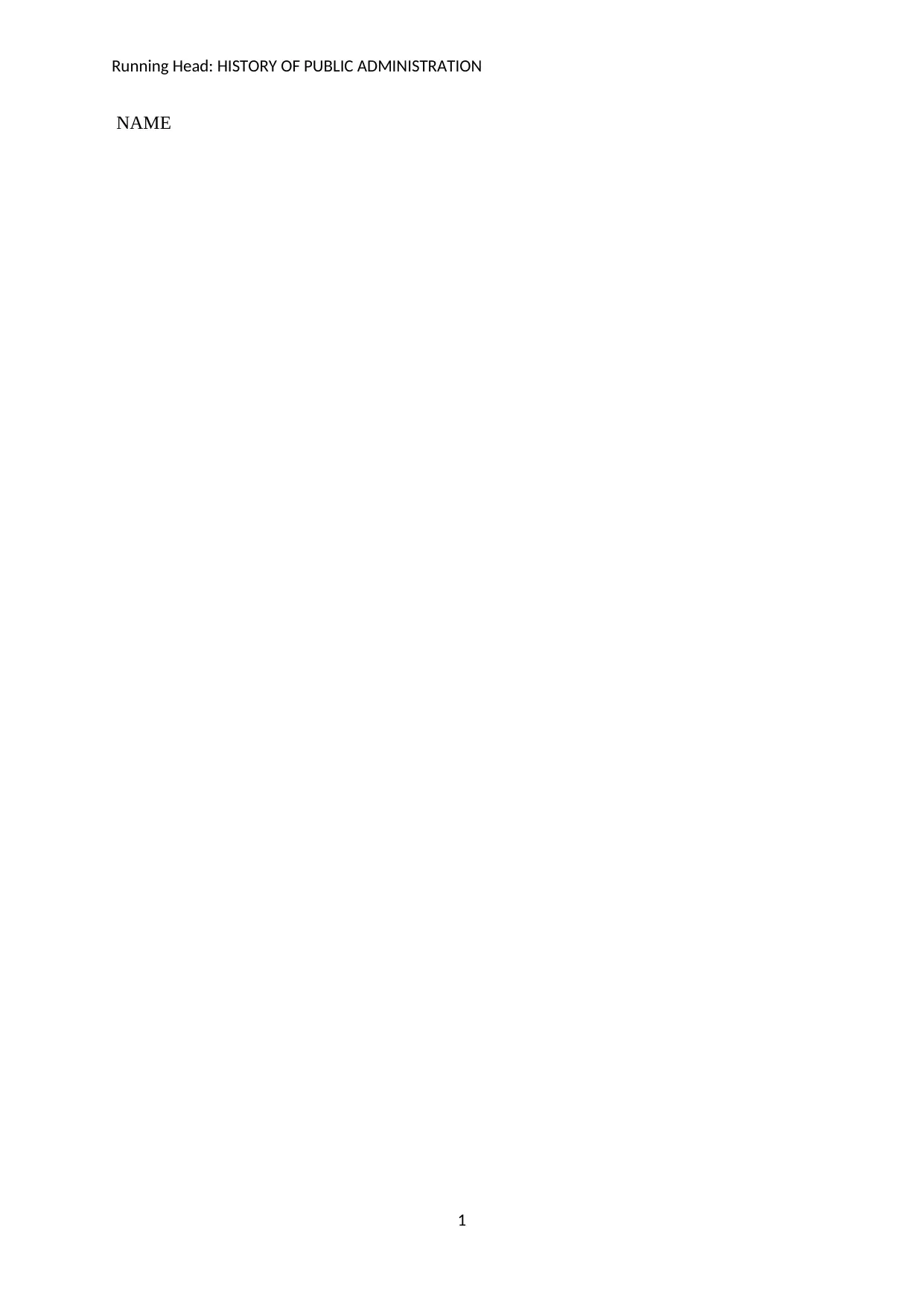
Running Head: HISTORY OF PUBLIC ADMINISTRATION
NAME
1
NAME
1
Paraphrase This Document
Need a fresh take? Get an instant paraphrase of this document with our AI Paraphraser
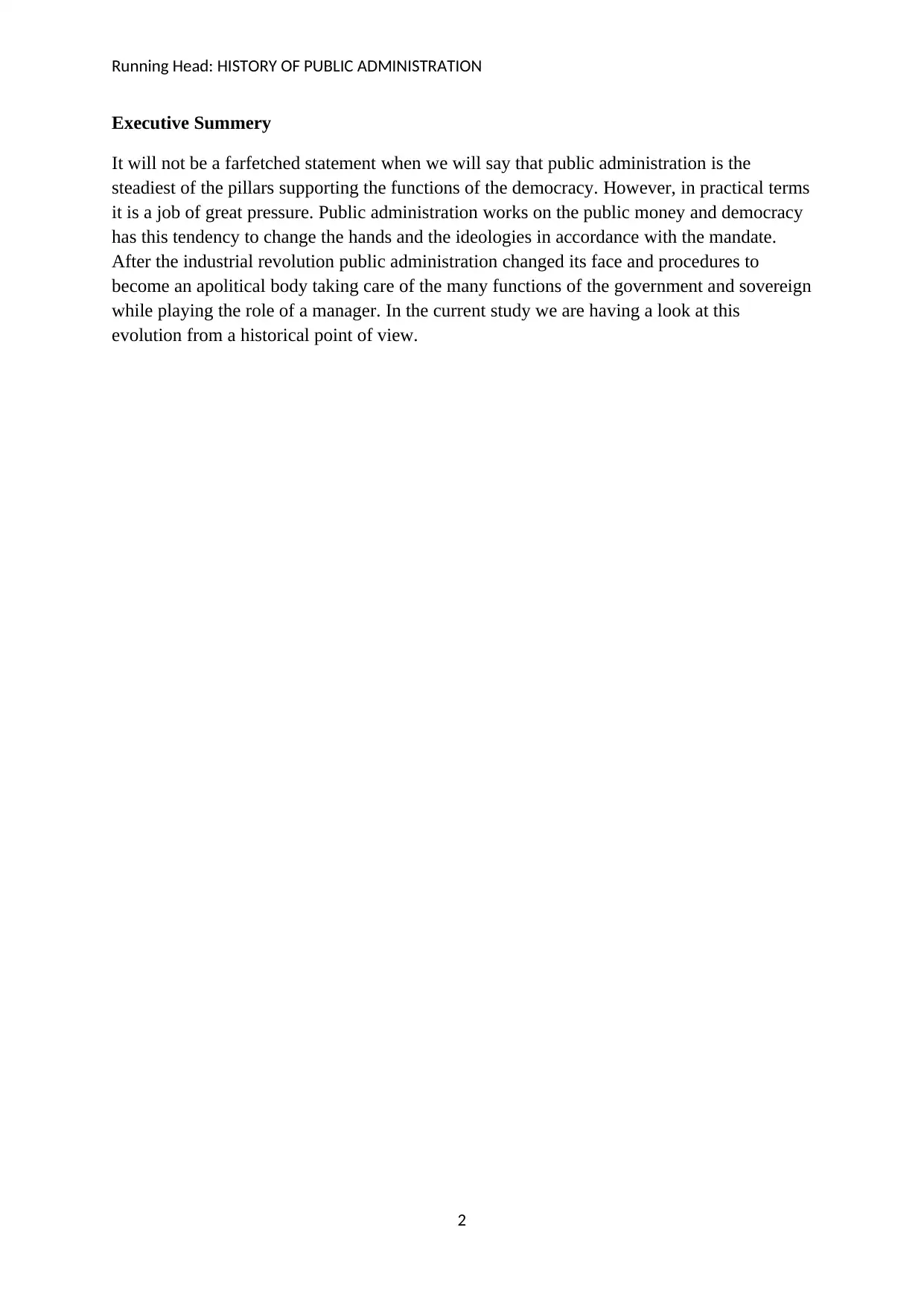
Running Head: HISTORY OF PUBLIC ADMINISTRATION
Executive Summery
It will not be a farfetched statement when we will say that public administration is the
steadiest of the pillars supporting the functions of the democracy. However, in practical terms
it is a job of great pressure. Public administration works on the public money and democracy
has this tendency to change the hands and the ideologies in accordance with the mandate.
After the industrial revolution public administration changed its face and procedures to
become an apolitical body taking care of the many functions of the government and sovereign
while playing the role of a manager. In the current study we are having a look at this
evolution from a historical point of view.
2
Executive Summery
It will not be a farfetched statement when we will say that public administration is the
steadiest of the pillars supporting the functions of the democracy. However, in practical terms
it is a job of great pressure. Public administration works on the public money and democracy
has this tendency to change the hands and the ideologies in accordance with the mandate.
After the industrial revolution public administration changed its face and procedures to
become an apolitical body taking care of the many functions of the government and sovereign
while playing the role of a manager. In the current study we are having a look at this
evolution from a historical point of view.
2
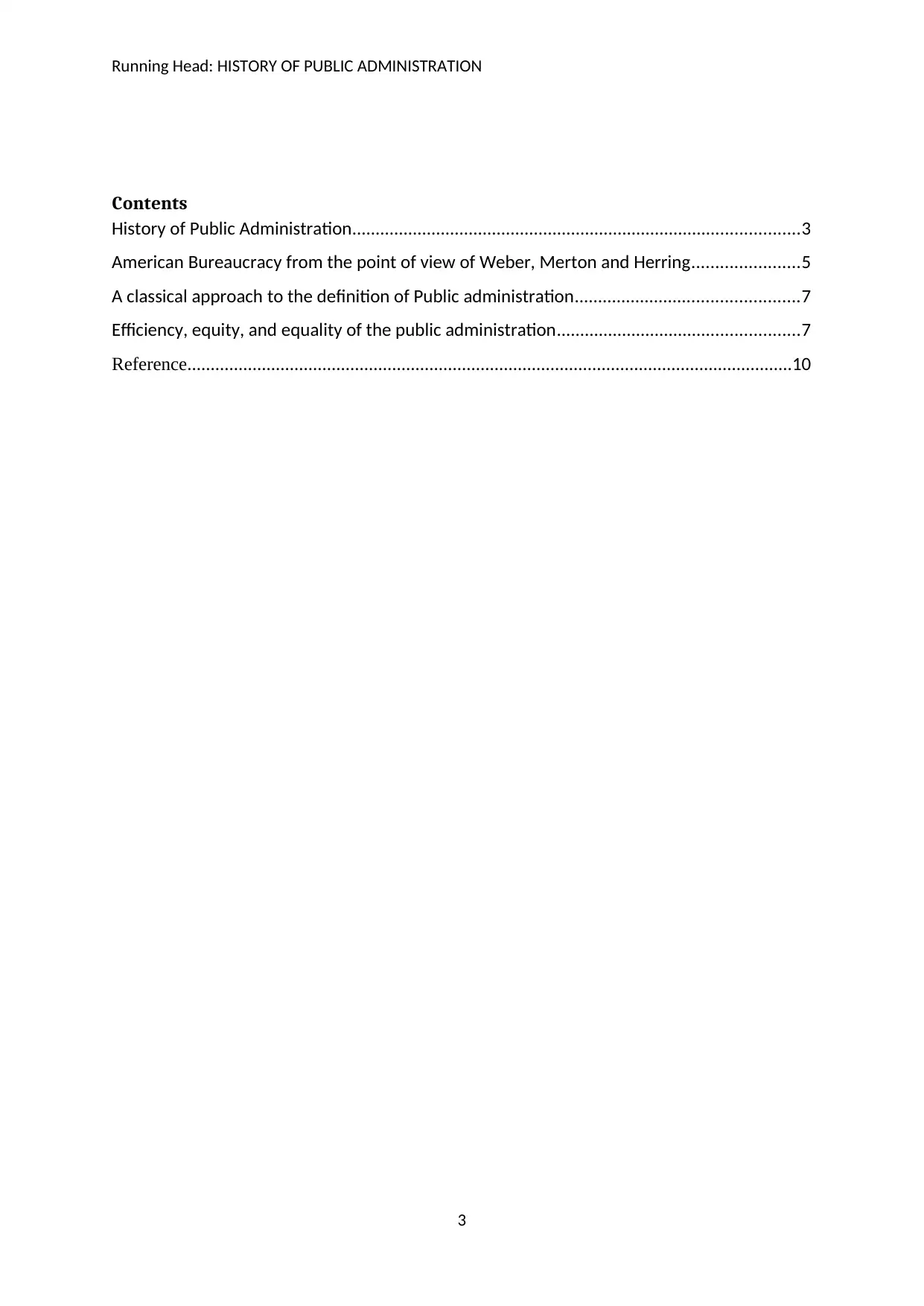
Running Head: HISTORY OF PUBLIC ADMINISTRATION
Contents
History of Public Administration................................................................................................3
American Bureaucracy from the point of view of Weber, Merton and Herring.......................5
A classical approach to the definition of Public administration................................................7
Efficiency, equity, and equality of the public administration....................................................7
Reference..................................................................................................................................10
3
Contents
History of Public Administration................................................................................................3
American Bureaucracy from the point of view of Weber, Merton and Herring.......................5
A classical approach to the definition of Public administration................................................7
Efficiency, equity, and equality of the public administration....................................................7
Reference..................................................................................................................................10
3
⊘ This is a preview!⊘
Do you want full access?
Subscribe today to unlock all pages.

Trusted by 1+ million students worldwide
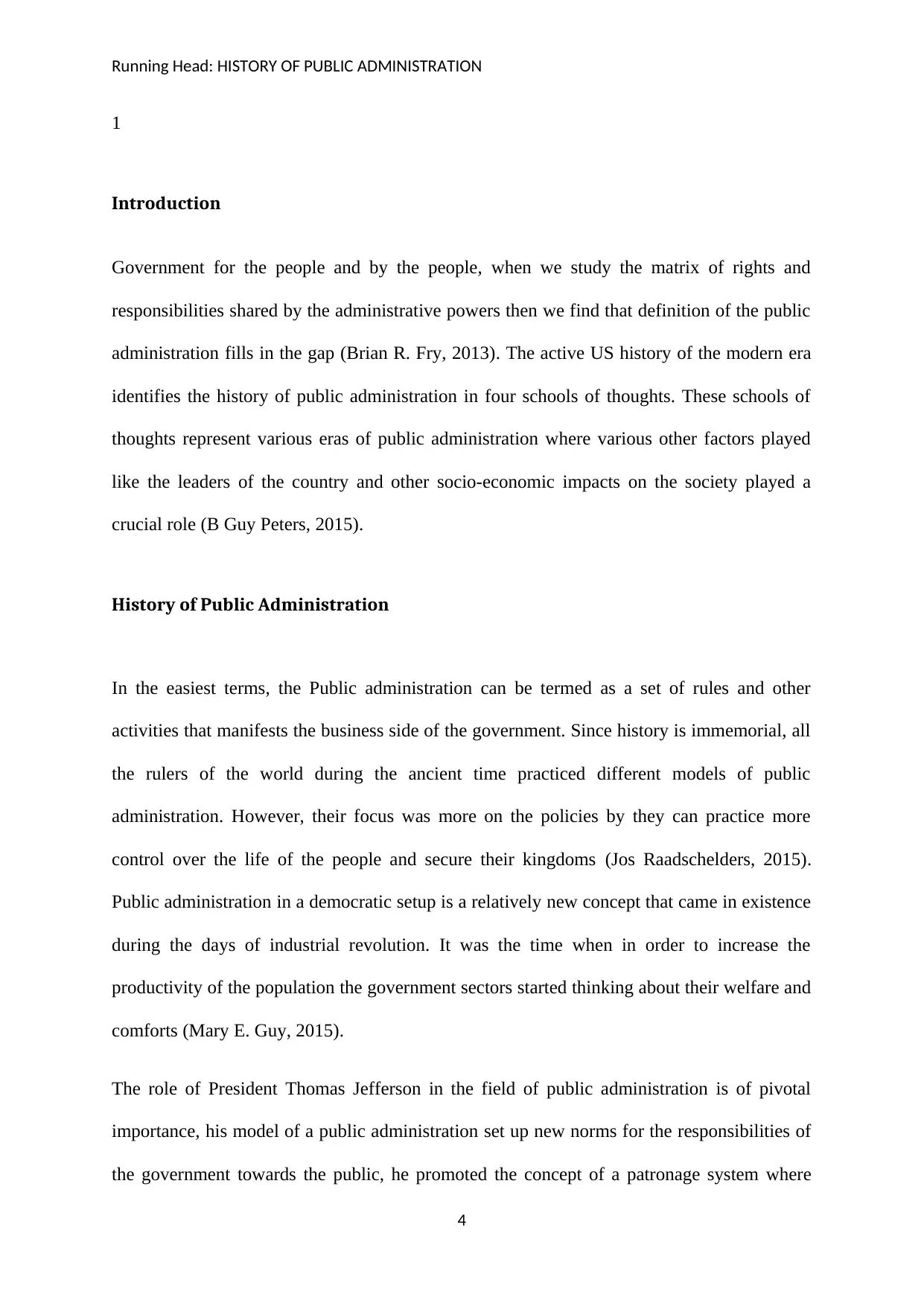
Running Head: HISTORY OF PUBLIC ADMINISTRATION
1
Introduction
Government for the people and by the people, when we study the matrix of rights and
responsibilities shared by the administrative powers then we find that definition of the public
administration fills in the gap (Brian R. Fry, 2013). The active US history of the modern era
identifies the history of public administration in four schools of thoughts. These schools of
thoughts represent various eras of public administration where various other factors played
like the leaders of the country and other socio-economic impacts on the society played a
crucial role (B Guy Peters, 2015).
History of Public Administration
In the easiest terms, the Public administration can be termed as a set of rules and other
activities that manifests the business side of the government. Since history is immemorial, all
the rulers of the world during the ancient time practiced different models of public
administration. However, their focus was more on the policies by they can practice more
control over the life of the people and secure their kingdoms (Jos Raadschelders, 2015).
Public administration in a democratic setup is a relatively new concept that came in existence
during the days of industrial revolution. It was the time when in order to increase the
productivity of the population the government sectors started thinking about their welfare and
comforts (Mary E. Guy, 2015).
The role of President Thomas Jefferson in the field of public administration is of pivotal
importance, his model of a public administration set up new norms for the responsibilities of
the government towards the public, he promoted the concept of a patronage system where
4
1
Introduction
Government for the people and by the people, when we study the matrix of rights and
responsibilities shared by the administrative powers then we find that definition of the public
administration fills in the gap (Brian R. Fry, 2013). The active US history of the modern era
identifies the history of public administration in four schools of thoughts. These schools of
thoughts represent various eras of public administration where various other factors played
like the leaders of the country and other socio-economic impacts on the society played a
crucial role (B Guy Peters, 2015).
History of Public Administration
In the easiest terms, the Public administration can be termed as a set of rules and other
activities that manifests the business side of the government. Since history is immemorial, all
the rulers of the world during the ancient time practiced different models of public
administration. However, their focus was more on the policies by they can practice more
control over the life of the people and secure their kingdoms (Jos Raadschelders, 2015).
Public administration in a democratic setup is a relatively new concept that came in existence
during the days of industrial revolution. It was the time when in order to increase the
productivity of the population the government sectors started thinking about their welfare and
comforts (Mary E. Guy, 2015).
The role of President Thomas Jefferson in the field of public administration is of pivotal
importance, his model of a public administration set up new norms for the responsibilities of
the government towards the public, he promoted the concept of a patronage system where
4
Paraphrase This Document
Need a fresh take? Get an instant paraphrase of this document with our AI Paraphraser
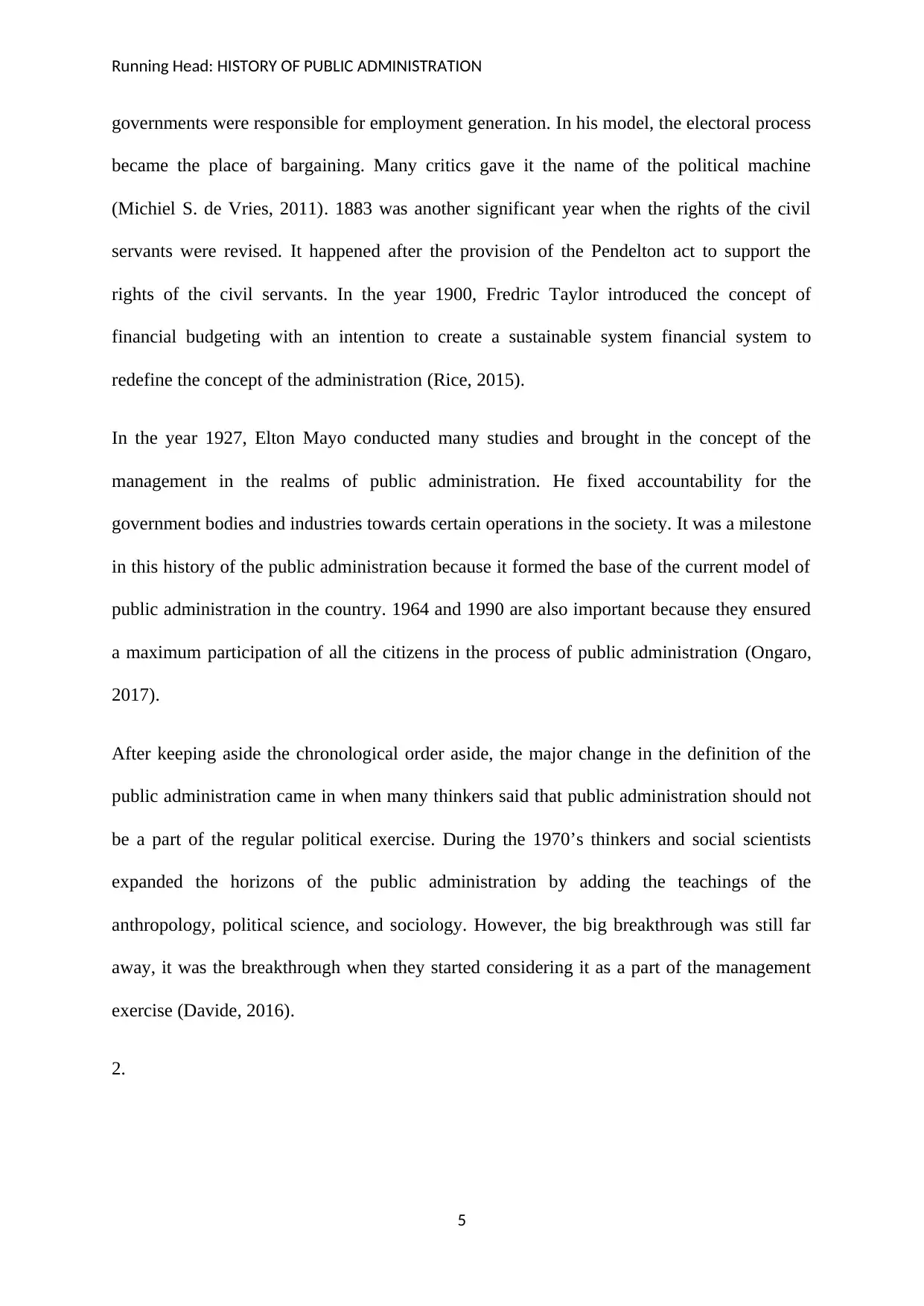
Running Head: HISTORY OF PUBLIC ADMINISTRATION
governments were responsible for employment generation. In his model, the electoral process
became the place of bargaining. Many critics gave it the name of the political machine
(Michiel S. de Vries, 2011). 1883 was another significant year when the rights of the civil
servants were revised. It happened after the provision of the Pendelton act to support the
rights of the civil servants. In the year 1900, Fredric Taylor introduced the concept of
financial budgeting with an intention to create a sustainable system financial system to
redefine the concept of the administration (Rice, 2015).
In the year 1927, Elton Mayo conducted many studies and brought in the concept of the
management in the realms of public administration. He fixed accountability for the
government bodies and industries towards certain operations in the society. It was a milestone
in this history of the public administration because it formed the base of the current model of
public administration in the country. 1964 and 1990 are also important because they ensured
a maximum participation of all the citizens in the process of public administration (Ongaro,
2017).
After keeping aside the chronological order aside, the major change in the definition of the
public administration came in when many thinkers said that public administration should not
be a part of the regular political exercise. During the 1970’s thinkers and social scientists
expanded the horizons of the public administration by adding the teachings of the
anthropology, political science, and sociology. However, the big breakthrough was still far
away, it was the breakthrough when they started considering it as a part of the management
exercise (Davide, 2016).
2.
5
governments were responsible for employment generation. In his model, the electoral process
became the place of bargaining. Many critics gave it the name of the political machine
(Michiel S. de Vries, 2011). 1883 was another significant year when the rights of the civil
servants were revised. It happened after the provision of the Pendelton act to support the
rights of the civil servants. In the year 1900, Fredric Taylor introduced the concept of
financial budgeting with an intention to create a sustainable system financial system to
redefine the concept of the administration (Rice, 2015).
In the year 1927, Elton Mayo conducted many studies and brought in the concept of the
management in the realms of public administration. He fixed accountability for the
government bodies and industries towards certain operations in the society. It was a milestone
in this history of the public administration because it formed the base of the current model of
public administration in the country. 1964 and 1990 are also important because they ensured
a maximum participation of all the citizens in the process of public administration (Ongaro,
2017).
After keeping aside the chronological order aside, the major change in the definition of the
public administration came in when many thinkers said that public administration should not
be a part of the regular political exercise. During the 1970’s thinkers and social scientists
expanded the horizons of the public administration by adding the teachings of the
anthropology, political science, and sociology. However, the big breakthrough was still far
away, it was the breakthrough when they started considering it as a part of the management
exercise (Davide, 2016).
2.
5
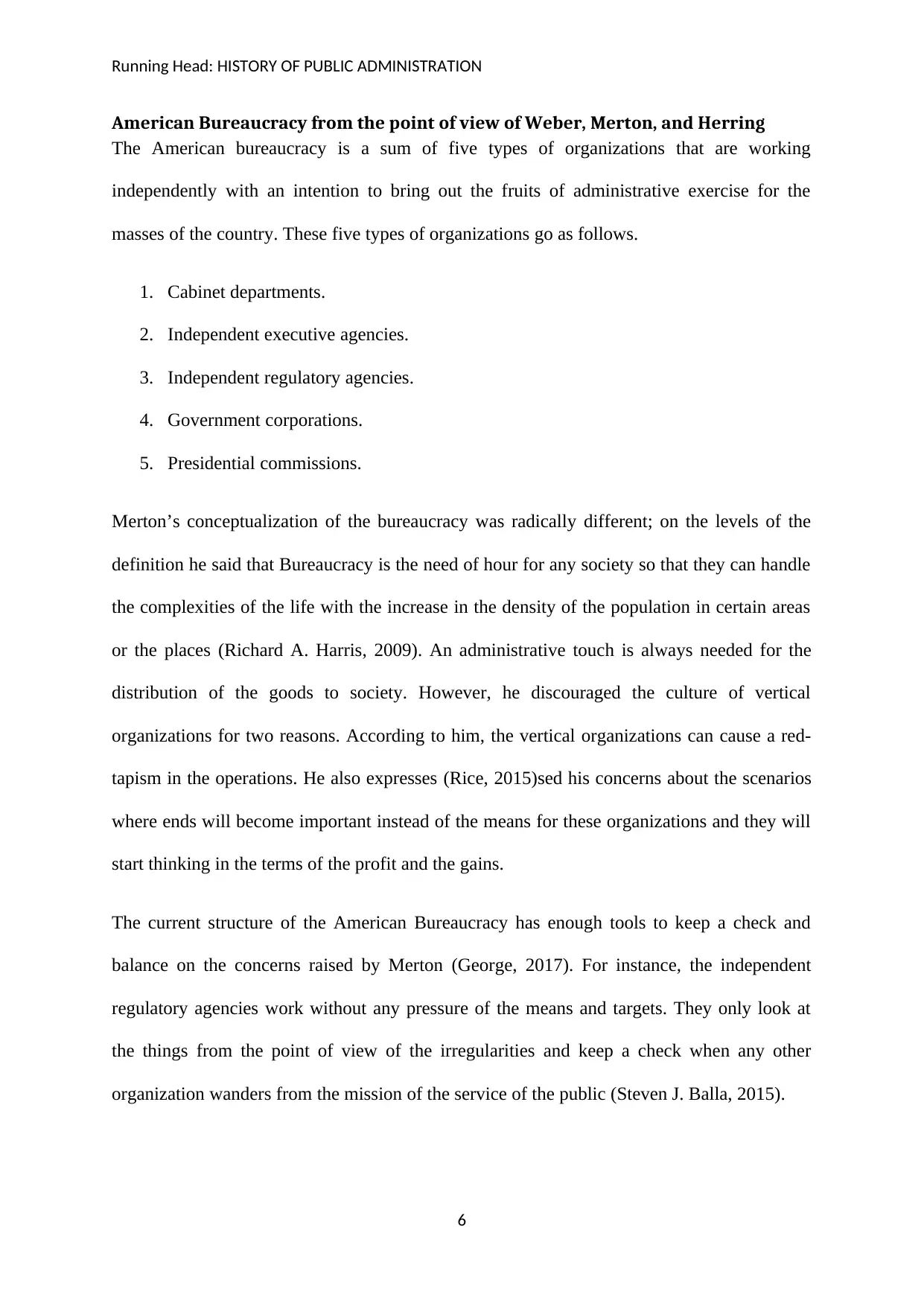
Running Head: HISTORY OF PUBLIC ADMINISTRATION
American Bureaucracy from the point of view of Weber, Merton, and Herring
The American bureaucracy is a sum of five types of organizations that are working
independently with an intention to bring out the fruits of administrative exercise for the
masses of the country. These five types of organizations go as follows.
1. Cabinet departments.
2. Independent executive agencies.
3. Independent regulatory agencies.
4. Government corporations.
5. Presidential commissions.
Merton’s conceptualization of the bureaucracy was radically different; on the levels of the
definition he said that Bureaucracy is the need of hour for any society so that they can handle
the complexities of the life with the increase in the density of the population in certain areas
or the places (Richard A. Harris, 2009). An administrative touch is always needed for the
distribution of the goods to society. However, he discouraged the culture of vertical
organizations for two reasons. According to him, the vertical organizations can cause a red-
tapism in the operations. He also expresses (Rice, 2015)sed his concerns about the scenarios
where ends will become important instead of the means for these organizations and they will
start thinking in the terms of the profit and the gains.
The current structure of the American Bureaucracy has enough tools to keep a check and
balance on the concerns raised by Merton (George, 2017). For instance, the independent
regulatory agencies work without any pressure of the means and targets. They only look at
the things from the point of view of the irregularities and keep a check when any other
organization wanders from the mission of the service of the public (Steven J. Balla, 2015).
6
American Bureaucracy from the point of view of Weber, Merton, and Herring
The American bureaucracy is a sum of five types of organizations that are working
independently with an intention to bring out the fruits of administrative exercise for the
masses of the country. These five types of organizations go as follows.
1. Cabinet departments.
2. Independent executive agencies.
3. Independent regulatory agencies.
4. Government corporations.
5. Presidential commissions.
Merton’s conceptualization of the bureaucracy was radically different; on the levels of the
definition he said that Bureaucracy is the need of hour for any society so that they can handle
the complexities of the life with the increase in the density of the population in certain areas
or the places (Richard A. Harris, 2009). An administrative touch is always needed for the
distribution of the goods to society. However, he discouraged the culture of vertical
organizations for two reasons. According to him, the vertical organizations can cause a red-
tapism in the operations. He also expresses (Rice, 2015)sed his concerns about the scenarios
where ends will become important instead of the means for these organizations and they will
start thinking in the terms of the profit and the gains.
The current structure of the American Bureaucracy has enough tools to keep a check and
balance on the concerns raised by Merton (George, 2017). For instance, the independent
regulatory agencies work without any pressure of the means and targets. They only look at
the things from the point of view of the irregularities and keep a check when any other
organization wanders from the mission of the service of the public (Steven J. Balla, 2015).
6
⊘ This is a preview!⊘
Do you want full access?
Subscribe today to unlock all pages.

Trusted by 1+ million students worldwide
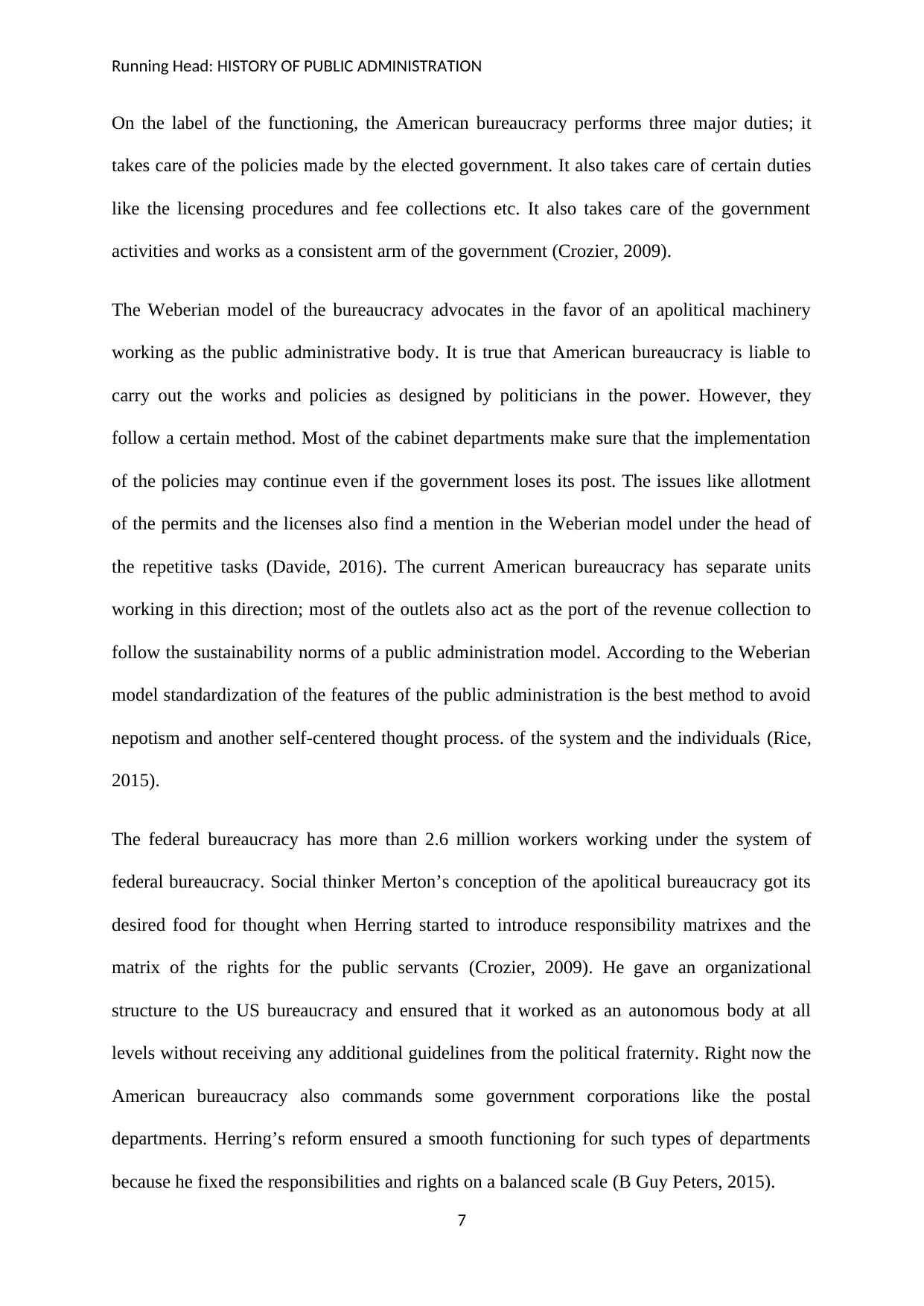
Running Head: HISTORY OF PUBLIC ADMINISTRATION
On the label of the functioning, the American bureaucracy performs three major duties; it
takes care of the policies made by the elected government. It also takes care of certain duties
like the licensing procedures and fee collections etc. It also takes care of the government
activities and works as a consistent arm of the government (Crozier, 2009).
The Weberian model of the bureaucracy advocates in the favor of an apolitical machinery
working as the public administrative body. It is true that American bureaucracy is liable to
carry out the works and policies as designed by politicians in the power. However, they
follow a certain method. Most of the cabinet departments make sure that the implementation
of the policies may continue even if the government loses its post. The issues like allotment
of the permits and the licenses also find a mention in the Weberian model under the head of
the repetitive tasks (Davide, 2016). The current American bureaucracy has separate units
working in this direction; most of the outlets also act as the port of the revenue collection to
follow the sustainability norms of a public administration model. According to the Weberian
model standardization of the features of the public administration is the best method to avoid
nepotism and another self-centered thought process. of the system and the individuals (Rice,
2015).
The federal bureaucracy has more than 2.6 million workers working under the system of
federal bureaucracy. Social thinker Merton’s conception of the apolitical bureaucracy got its
desired food for thought when Herring started to introduce responsibility matrixes and the
matrix of the rights for the public servants (Crozier, 2009). He gave an organizational
structure to the US bureaucracy and ensured that it worked as an autonomous body at all
levels without receiving any additional guidelines from the political fraternity. Right now the
American bureaucracy also commands some government corporations like the postal
departments. Herring’s reform ensured a smooth functioning for such types of departments
because he fixed the responsibilities and rights on a balanced scale (B Guy Peters, 2015).
7
On the label of the functioning, the American bureaucracy performs three major duties; it
takes care of the policies made by the elected government. It also takes care of certain duties
like the licensing procedures and fee collections etc. It also takes care of the government
activities and works as a consistent arm of the government (Crozier, 2009).
The Weberian model of the bureaucracy advocates in the favor of an apolitical machinery
working as the public administrative body. It is true that American bureaucracy is liable to
carry out the works and policies as designed by politicians in the power. However, they
follow a certain method. Most of the cabinet departments make sure that the implementation
of the policies may continue even if the government loses its post. The issues like allotment
of the permits and the licenses also find a mention in the Weberian model under the head of
the repetitive tasks (Davide, 2016). The current American bureaucracy has separate units
working in this direction; most of the outlets also act as the port of the revenue collection to
follow the sustainability norms of a public administration model. According to the Weberian
model standardization of the features of the public administration is the best method to avoid
nepotism and another self-centered thought process. of the system and the individuals (Rice,
2015).
The federal bureaucracy has more than 2.6 million workers working under the system of
federal bureaucracy. Social thinker Merton’s conception of the apolitical bureaucracy got its
desired food for thought when Herring started to introduce responsibility matrixes and the
matrix of the rights for the public servants (Crozier, 2009). He gave an organizational
structure to the US bureaucracy and ensured that it worked as an autonomous body at all
levels without receiving any additional guidelines from the political fraternity. Right now the
American bureaucracy also commands some government corporations like the postal
departments. Herring’s reform ensured a smooth functioning for such types of departments
because he fixed the responsibilities and rights on a balanced scale (B Guy Peters, 2015).
7
Paraphrase This Document
Need a fresh take? Get an instant paraphrase of this document with our AI Paraphraser
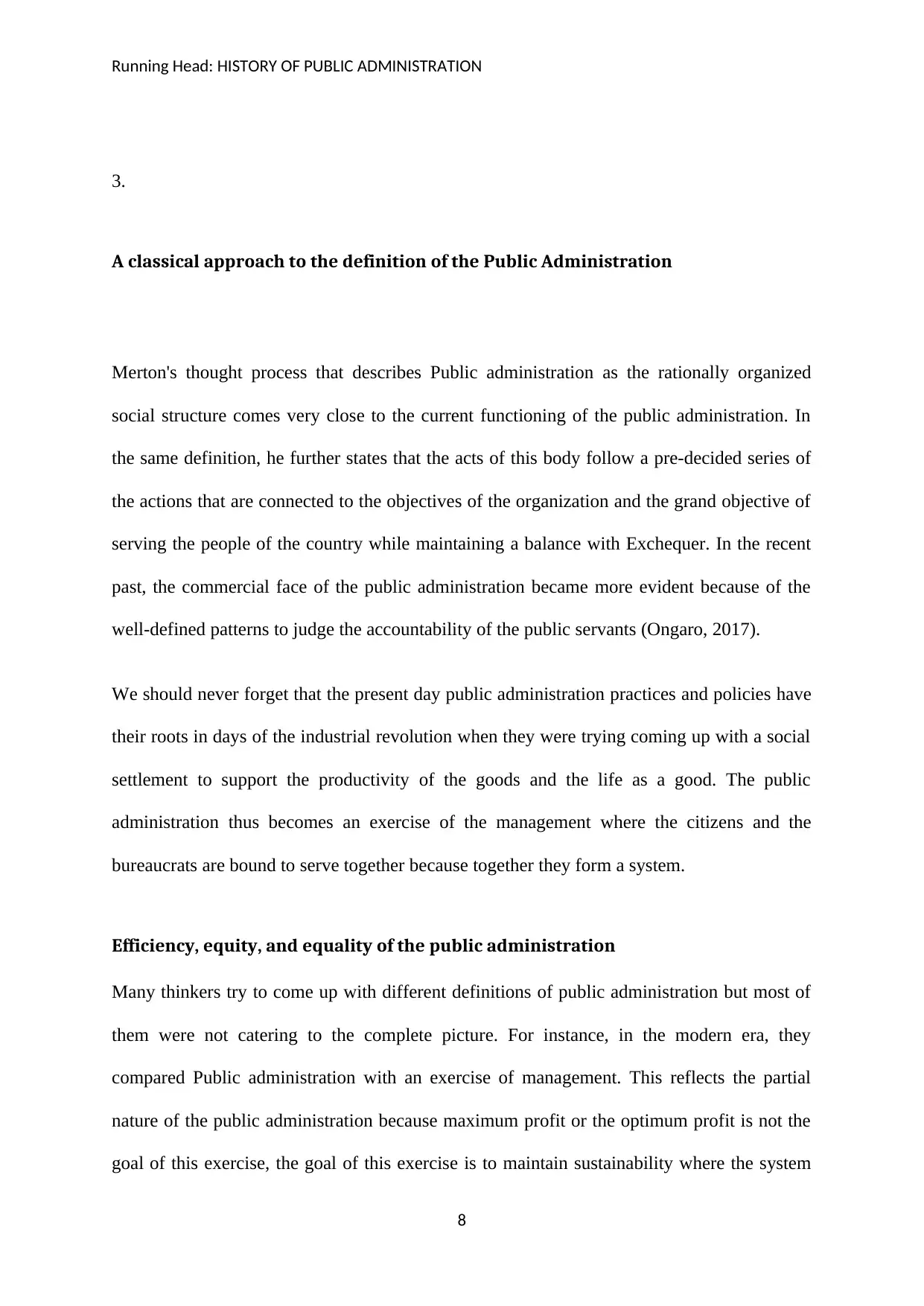
Running Head: HISTORY OF PUBLIC ADMINISTRATION
3.
A classical approach to the definition of the Public Administration
Merton's thought process that describes Public administration as the rationally organized
social structure comes very close to the current functioning of the public administration. In
the same definition, he further states that the acts of this body follow a pre-decided series of
the actions that are connected to the objectives of the organization and the grand objective of
serving the people of the country while maintaining a balance with Exchequer. In the recent
past, the commercial face of the public administration became more evident because of the
well-defined patterns to judge the accountability of the public servants (Ongaro, 2017).
We should never forget that the present day public administration practices and policies have
their roots in days of the industrial revolution when they were trying coming up with a social
settlement to support the productivity of the goods and the life as a good. The public
administration thus becomes an exercise of the management where the citizens and the
bureaucrats are bound to serve together because together they form a system.
Efficiency, equity, and equality of the public administration
Many thinkers try to come up with different definitions of public administration but most of
them were not catering to the complete picture. For instance, in the modern era, they
compared Public administration with an exercise of management. This reflects the partial
nature of the public administration because maximum profit or the optimum profit is not the
goal of this exercise, the goal of this exercise is to maintain sustainability where the system
8
3.
A classical approach to the definition of the Public Administration
Merton's thought process that describes Public administration as the rationally organized
social structure comes very close to the current functioning of the public administration. In
the same definition, he further states that the acts of this body follow a pre-decided series of
the actions that are connected to the objectives of the organization and the grand objective of
serving the people of the country while maintaining a balance with Exchequer. In the recent
past, the commercial face of the public administration became more evident because of the
well-defined patterns to judge the accountability of the public servants (Ongaro, 2017).
We should never forget that the present day public administration practices and policies have
their roots in days of the industrial revolution when they were trying coming up with a social
settlement to support the productivity of the goods and the life as a good. The public
administration thus becomes an exercise of the management where the citizens and the
bureaucrats are bound to serve together because together they form a system.
Efficiency, equity, and equality of the public administration
Many thinkers try to come up with different definitions of public administration but most of
them were not catering to the complete picture. For instance, in the modern era, they
compared Public administration with an exercise of management. This reflects the partial
nature of the public administration because maximum profit or the optimum profit is not the
goal of this exercise, the goal of this exercise is to maintain sustainability where the system
8
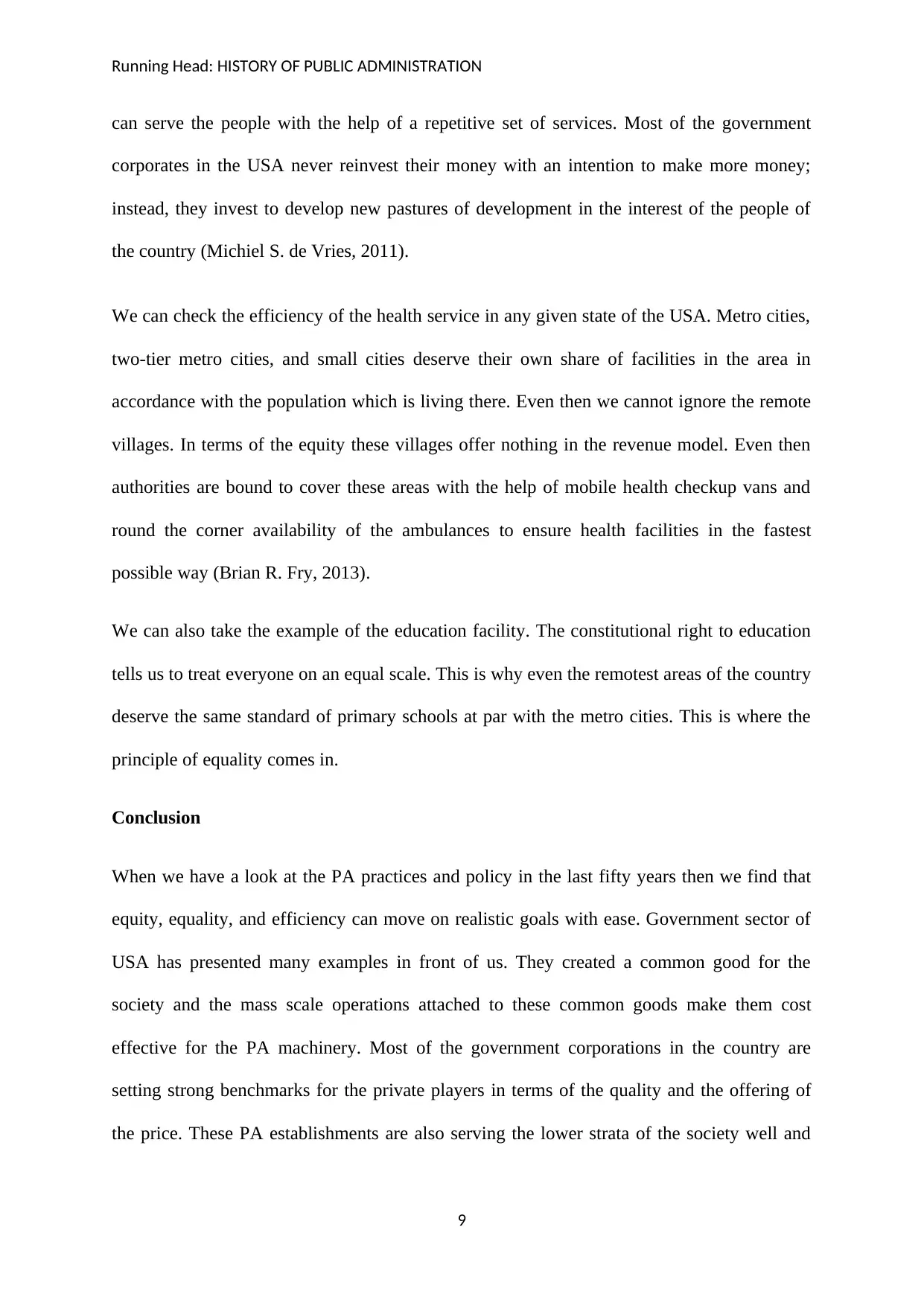
Running Head: HISTORY OF PUBLIC ADMINISTRATION
can serve the people with the help of a repetitive set of services. Most of the government
corporates in the USA never reinvest their money with an intention to make more money;
instead, they invest to develop new pastures of development in the interest of the people of
the country (Michiel S. de Vries, 2011).
We can check the efficiency of the health service in any given state of the USA. Metro cities,
two-tier metro cities, and small cities deserve their own share of facilities in the area in
accordance with the population which is living there. Even then we cannot ignore the remote
villages. In terms of the equity these villages offer nothing in the revenue model. Even then
authorities are bound to cover these areas with the help of mobile health checkup vans and
round the corner availability of the ambulances to ensure health facilities in the fastest
possible way (Brian R. Fry, 2013).
We can also take the example of the education facility. The constitutional right to education
tells us to treat everyone on an equal scale. This is why even the remotest areas of the country
deserve the same standard of primary schools at par with the metro cities. This is where the
principle of equality comes in.
Conclusion
When we have a look at the PA practices and policy in the last fifty years then we find that
equity, equality, and efficiency can move on realistic goals with ease. Government sector of
USA has presented many examples in front of us. They created a common good for the
society and the mass scale operations attached to these common goods make them cost
effective for the PA machinery. Most of the government corporations in the country are
setting strong benchmarks for the private players in terms of the quality and the offering of
the price. These PA establishments are also serving the lower strata of the society well and
9
can serve the people with the help of a repetitive set of services. Most of the government
corporates in the USA never reinvest their money with an intention to make more money;
instead, they invest to develop new pastures of development in the interest of the people of
the country (Michiel S. de Vries, 2011).
We can check the efficiency of the health service in any given state of the USA. Metro cities,
two-tier metro cities, and small cities deserve their own share of facilities in the area in
accordance with the population which is living there. Even then we cannot ignore the remote
villages. In terms of the equity these villages offer nothing in the revenue model. Even then
authorities are bound to cover these areas with the help of mobile health checkup vans and
round the corner availability of the ambulances to ensure health facilities in the fastest
possible way (Brian R. Fry, 2013).
We can also take the example of the education facility. The constitutional right to education
tells us to treat everyone on an equal scale. This is why even the remotest areas of the country
deserve the same standard of primary schools at par with the metro cities. This is where the
principle of equality comes in.
Conclusion
When we have a look at the PA practices and policy in the last fifty years then we find that
equity, equality, and efficiency can move on realistic goals with ease. Government sector of
USA has presented many examples in front of us. They created a common good for the
society and the mass scale operations attached to these common goods make them cost
effective for the PA machinery. Most of the government corporations in the country are
setting strong benchmarks for the private players in terms of the quality and the offering of
the price. These PA establishments are also serving the lower strata of the society well and
9
⊘ This is a preview!⊘
Do you want full access?
Subscribe today to unlock all pages.

Trusted by 1+ million students worldwide
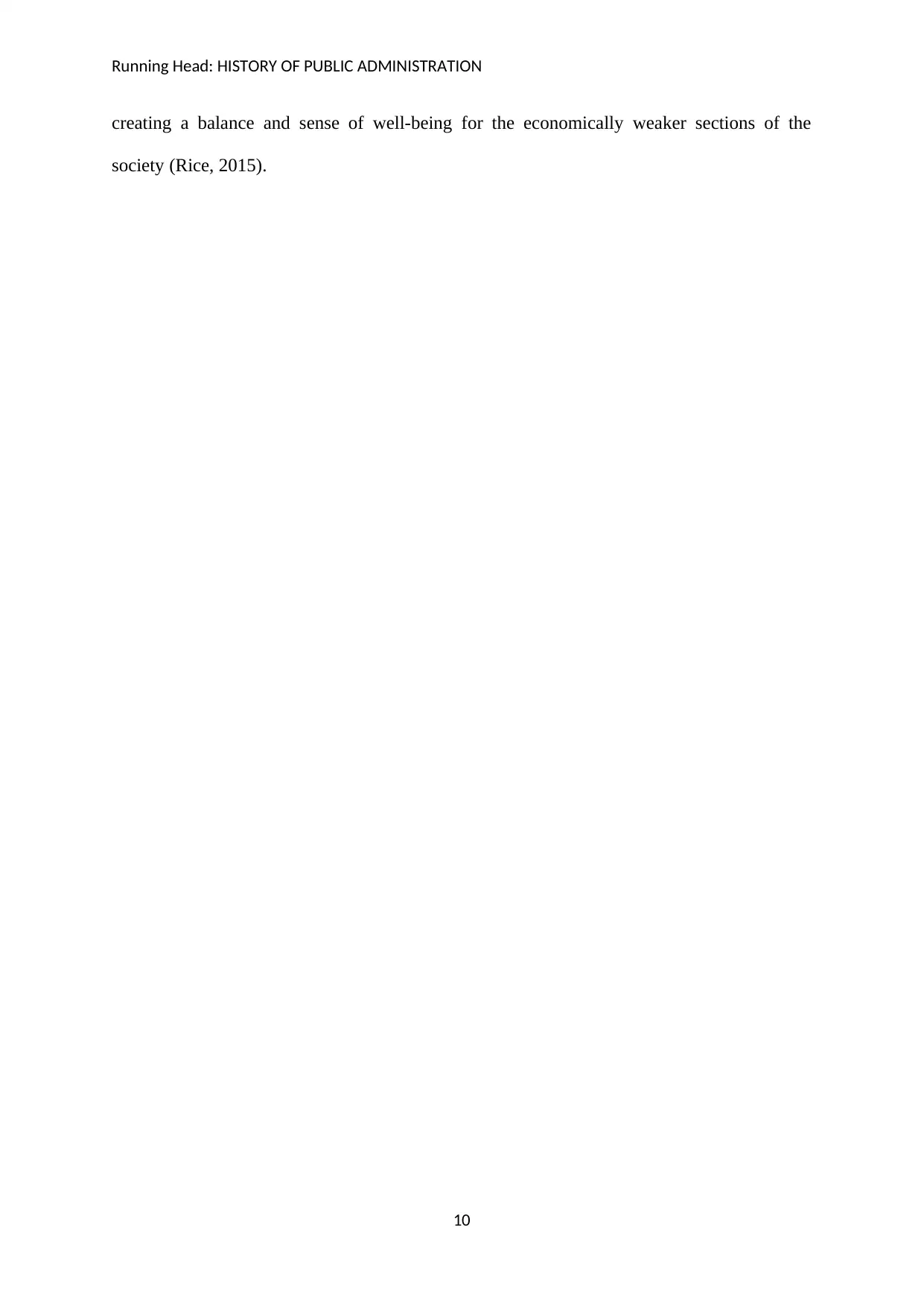
Running Head: HISTORY OF PUBLIC ADMINISTRATION
creating a balance and sense of well-being for the economically weaker sections of the
society (Rice, 2015).
10
creating a balance and sense of well-being for the economically weaker sections of the
society (Rice, 2015).
10
Paraphrase This Document
Need a fresh take? Get an instant paraphrase of this document with our AI Paraphraser
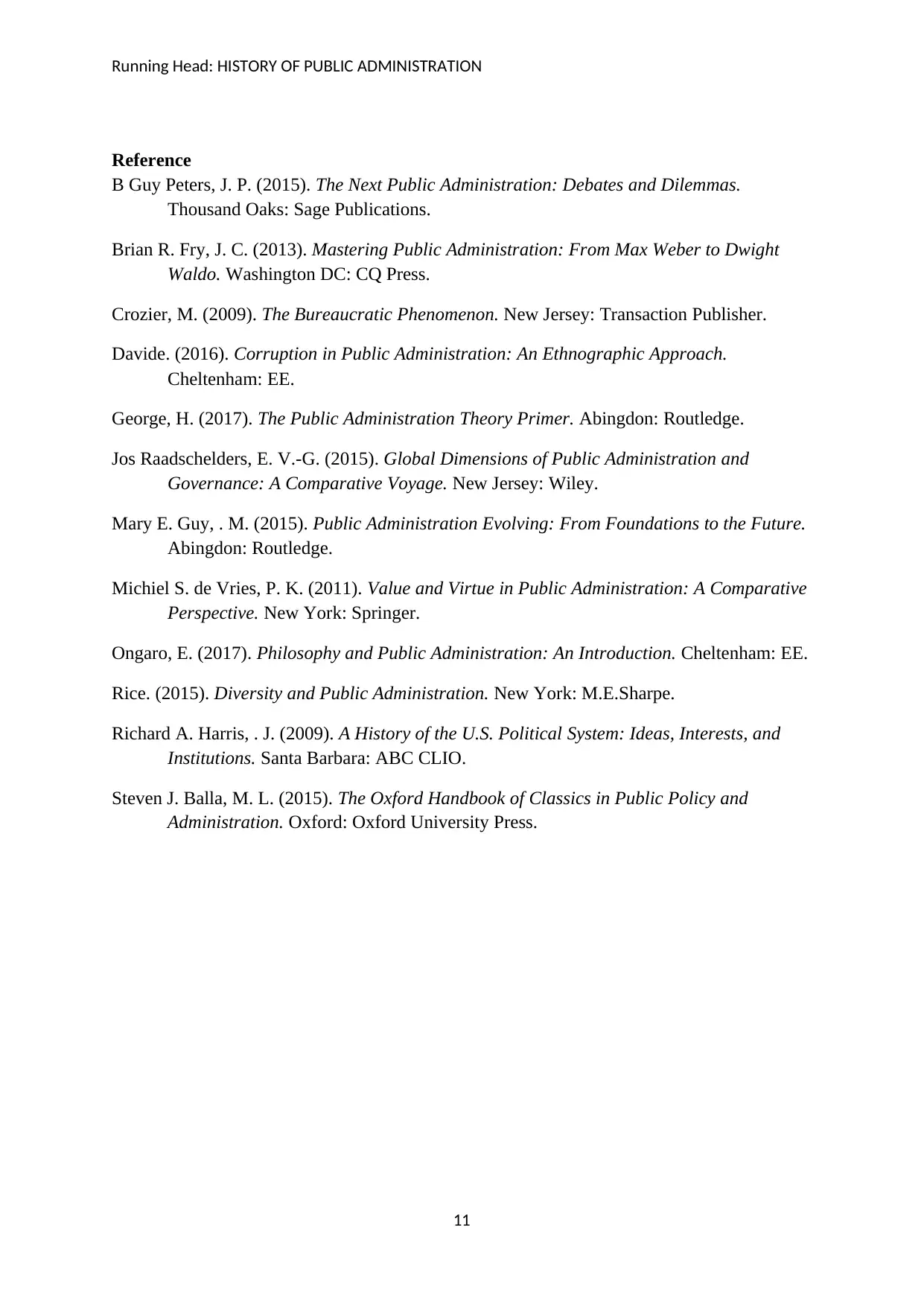
Running Head: HISTORY OF PUBLIC ADMINISTRATION
Reference
B Guy Peters, J. P. (2015). The Next Public Administration: Debates and Dilemmas.
Thousand Oaks: Sage Publications.
Brian R. Fry, J. C. (2013). Mastering Public Administration: From Max Weber to Dwight
Waldo. Washington DC: CQ Press.
Crozier, M. (2009). The Bureaucratic Phenomenon. New Jersey: Transaction Publisher.
Davide. (2016). Corruption in Public Administration: An Ethnographic Approach.
Cheltenham: EE.
George, H. (2017). The Public Administration Theory Primer. Abingdon: Routledge.
Jos Raadschelders, E. V.-G. (2015). Global Dimensions of Public Administration and
Governance: A Comparative Voyage. New Jersey: Wiley.
Mary E. Guy, . M. (2015). Public Administration Evolving: From Foundations to the Future.
Abingdon: Routledge.
Michiel S. de Vries, P. K. (2011). Value and Virtue in Public Administration: A Comparative
Perspective. New York: Springer.
Ongaro, E. (2017). Philosophy and Public Administration: An Introduction. Cheltenham: EE.
Rice. (2015). Diversity and Public Administration. New York: M.E.Sharpe.
Richard A. Harris, . J. (2009). A History of the U.S. Political System: Ideas, Interests, and
Institutions. Santa Barbara: ABC CLIO.
Steven J. Balla, M. L. (2015). The Oxford Handbook of Classics in Public Policy and
Administration. Oxford: Oxford University Press.
11
Reference
B Guy Peters, J. P. (2015). The Next Public Administration: Debates and Dilemmas.
Thousand Oaks: Sage Publications.
Brian R. Fry, J. C. (2013). Mastering Public Administration: From Max Weber to Dwight
Waldo. Washington DC: CQ Press.
Crozier, M. (2009). The Bureaucratic Phenomenon. New Jersey: Transaction Publisher.
Davide. (2016). Corruption in Public Administration: An Ethnographic Approach.
Cheltenham: EE.
George, H. (2017). The Public Administration Theory Primer. Abingdon: Routledge.
Jos Raadschelders, E. V.-G. (2015). Global Dimensions of Public Administration and
Governance: A Comparative Voyage. New Jersey: Wiley.
Mary E. Guy, . M. (2015). Public Administration Evolving: From Foundations to the Future.
Abingdon: Routledge.
Michiel S. de Vries, P. K. (2011). Value and Virtue in Public Administration: A Comparative
Perspective. New York: Springer.
Ongaro, E. (2017). Philosophy and Public Administration: An Introduction. Cheltenham: EE.
Rice. (2015). Diversity and Public Administration. New York: M.E.Sharpe.
Richard A. Harris, . J. (2009). A History of the U.S. Political System: Ideas, Interests, and
Institutions. Santa Barbara: ABC CLIO.
Steven J. Balla, M. L. (2015). The Oxford Handbook of Classics in Public Policy and
Administration. Oxford: Oxford University Press.
11
1 out of 11
Related Documents
Your All-in-One AI-Powered Toolkit for Academic Success.
+13062052269
info@desklib.com
Available 24*7 on WhatsApp / Email
![[object Object]](/_next/static/media/star-bottom.7253800d.svg)
Unlock your academic potential
Copyright © 2020–2025 A2Z Services. All Rights Reserved. Developed and managed by ZUCOL.




